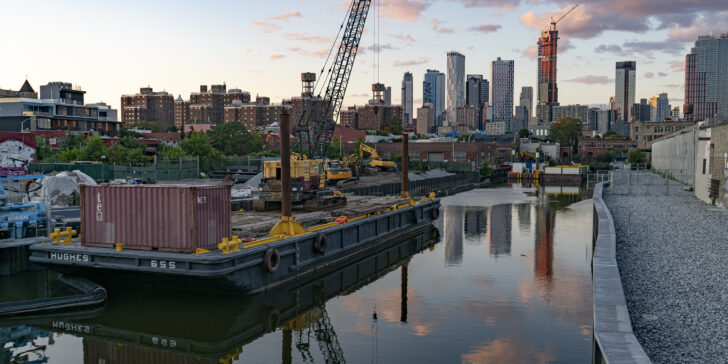
The City Council announced a deal Wednesday with the Mayor’s Office to reshape Brooklyn’s Gowanus neighborhood — bringing thousands of affordable apartments and hundreds of millions of dollars for public housing repairs and other crucial infrastructure projects.
Meanwhile, on Manhattan’s Upper East Side, a separate agreement put a significantly scaled down-version of New York Blood Center’s plan for a life-sciences hub is on the verge of full approval, despite the local Council member’s opposition.
And downtown, negotiations on the city’s push to rezone SoHo and NoHo to spur affordable housing development centered on the number of units and the future of retail in the trendy neighborhoods, according to City Council Speaker Corey Johnson.
The flurry of activity came as Mayor Bill de Blasio pushes for the passage of some signature projects — including using rezoning to diversify some of the city’s wealthiest and whitest neighborhoods — before he leaves office Dec. 31.
All the proposals have faced various levels of community opposition, including legal challenges. But the Gowanus and Blood Center projects are now set for pre-Thanksgiving votes by the Council, while the SoHo/NoHo plan will come down to the wire next month.
‘Fighting for Six Years’
The deal for the Gowanus rezoning solidified after the city committed big bucks for neighborhood improvements — including $200 million dollars for renovations to 1,662 public housing units at NYCHA’s Gowanus Houses and Wyckoff Gardens developments.
The rezoning had faced opposition, including a lawsuit that delayed the public review to this past April. But Councilmember Brad Lander (D-Brooklyn) said community members and City Hall ultimately came to an agreement that worked for many in the neighborhood.
“The reason we’re here is because public housing residents and tenants and homeowners and environmentalists and artists organized together to shape the plan, to push these things, partnered with the elected officials, partnered with the city to make sure it carries through on all those goals,” said Lander, who was recently elected city comptroller.
David Kutz, a photographer who is part of Arts Gowanus, a local arts group, said he became involved in the community negotiations because he believed the rezoning was inevitable.
“If we were at the table, there was a chance that we could do something for the community for the artists,” he said.
“We’ve been fighting for six years, and it hasn’t been easy,” said Monica Underwood, a community activist and resident of Wyckoff Gardens.
She said she was “so happy” Wednesday with what the city provided for the community, including job training and other services.
The rezoning would also spur the creation of up to 8,000 new apartments — about 3,000 of them deemed affordable — along with more shops and parks. The neighborhood overhaul also would include helping clean the polluted Gowanus Canal, a Superfund site.
‘Profound Impact on the City’
Residents on the Upper East Side fought rezoning for different reasons, supported by Councilmember Ben Kallos, who cited the shadows that would be cast on East 67th Street by the 16-story Blood Center building originally planned.
The Council announced a deal for the plan on Wednesday, knocking 100 feet in mechanical space off the proposed building. A subcommittee gave thumbs up and the full Council is expected to follow suit — even though it is very rare for the Council to vote against the local lawmaker’s position on a major proposal.
Councilmember Francisco Moya (D-Queens), who chairs the zoning and franchises subcommittee, said the Blood Center plan to provide blood services for the region’s hospitals while housing a life-sciences research hub packs citywide benefits.
“When we see that there are major rezonings that will have a profound impact on the city of New York itself, and when we hear from members from the committee, and members from our body that are in favor of a project, we have to take the step to listen to everyone here,” he said Wednesday.
Kallos told THE CITY Wednesday that he still believed he could secure enough “no” votes for the project — and his fight wasn’t over yet. He still considers the proposed building too big.
A Zoning ‘Penalty Tax’
SoHo and NoHo haven’t been rezoned since 1971, when artists looked to legalize the cheap industrial lofts they moved into, transforming what was once a manufacturing center.
The neighborhood is now one of the wealthiest and least-diverse parts of the city, officials said. The de Blasio administration hopes to change that by adding affordable housing, proposing units for at least 900 low-income households through the city’s Mandatory Inclusionary Housing program.
Supporters and opponents tussled over the plan at an hours-long hearing Tuesday, with foes calling the rezoning is a give-away to developers. They fear the zoning will allow too much density in a largely landmarked area and bring big-box retail shops.
Jane Fisher, a local resident, said at the hours-long hearing that the rezoning “aims to hit early SoHo settlers who built this neighborhood with a penalty tax on the fruits of their labor.”
On Wednesday, Johnson said the Council members were still negotiating the deal.
“It’s my understanding that they have been negotiating and doing work both on the affordable housing side, the retail side, I believe they had real concerns with big box stores,” he said.
This article was originally posted on Gowanus Housing Overhaul and Blood Center Expansion Headed for Approval After Council Strikes Deals